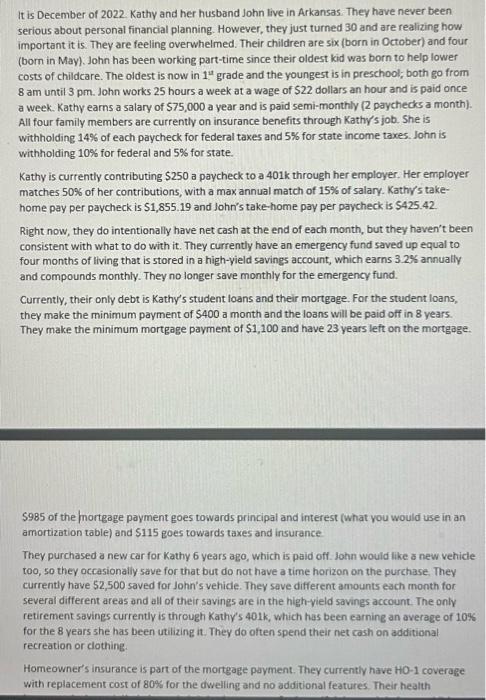Answered step by step
Verified Expert Solution
Question
1 Approved Answer
please show work It is December of 2022. Kathy and her husband John live in Arkansas. They have never been serious about personal financial planning.
please show work 

It is December of 2022. Kathy and her husband John live in Arkansas. They have never been serious about personal financial planning. However, they just turned 30 and are realizing how important it is. They are feeling overwhelmed. Their children are six (born in October) and four (born in May). John has been working part-time since their oldest kid was born to help lower costs of childcare. The oldest is now in 1t. grade and the youngest is in preschool; both go from 8 am until 3pm. John works 25 hours a week at a wage of $22 dollars an hour and is paid once a week. Kathy earns a salary of $75,000 a year and is paid semi-monthly ( 2 paychecks a month). All four family members are currently on insurance benefits through Kathy's job. She is withholding 14% of each paycheck for federal taxes and 5% for state income taxes. John is withholding 10% for federal and 5% for state. Kathy is currently contributing $250 a paycheck to a 401k through her employer. Her employer matches 50% of her contributions, with a max annual match of 15% of salary. Kathy's takehome pay per paycheck is $1,855.19 and John's take-home pay per paycheck is $425.42. Right now, they do intentionally have net cash at the end of each month, but they haven't been consistent with what to do with it. They currently have an emergency fund saved up equal to four months of living that is stored in a high-yield savings account, which earns 3.2% annually and compounds monthly. They no longer save monthly for the emergency fund. Currently, their only debt is Kathy's student loans and their mortgage. For the student loans, they make the minimum payment of $400 a month and the loans will be paid off in 8 years. They make the minimum mortgage payment of $1,100 and have 23 years left on the mortgage. $985 of the mortgage payment goes towards principal and interest (what you would use in an amortization table) and $115 goes towards taxes and insurance. They purchased a new car for Kathy 6 years ago, which is paid off. John would like a new vehicle too, so they ocrasionally save for that but do not have a time horizon on the purchase. They currently have $2,500 saved for John's vehice. They save different amounts each month for several different areas and all of their savings are in the high-vield savings account. The only retirement savings currently is through Kathy's 401k, which has been earning an average of 10% for the 8 years she has been utilizing it. They do often spend their net cash on additional recreation or clothing - Homeowner's insurance is part of the mortgage payment. They currently have HO-1 coverage with replacement cost of 80% for the dwelling and no additional features. Their health with replacement cost of 80%8 for the dweling and no additional features. Their health insurance is through Kathy's work. It is basic coverage for herself, John, and their two children. Through this coverage she does have six months of short-term disability for herself and John and 2 years of long-term disability for the both of them. She currently does not have dental or vision, choosing to pay out of pocket thus far. The only other insurance they have is for their cars, with basic coverage of 50/100/50 and no supplementals Part l: Goals! In order to make a solid and successful financial plan, we need to know what we want at different time horizons. One of the most important, and longest horizon, goals is saving for retirement. Kathy and John both plan to work another 35 years and retire at 65 years old. Kothy's 401k is a Lifecycle plan, which means that it shifts towards lower-risk assets as she approaches 65 years old. It is expected to earn 10% until she is 50 years old, when it will shift to earn 8% untili she is 60 years old. It will then shift again to return 5% until she is 65 years old and will retire. Kathy and John do not want to worry about running out of money, so they plan to live until they are 100 years old ( 35 years of retirement). They want to be able to withdraw today's value of 58,333 a month for an annual income of $100,000 a year during retirement. They also understand inflation, and they want $100,000 worth in today's dollars. They recognize they need to save more for retirement, so they plan to open a Roth IRA and maximize it by making monthly contributions of $541.67 (the annual maximum amount is $6,500 per account). They decide to go into a fund that expects to earn 11% and they plan to move that into a lower risk 6% plan when they turn 50 years old. When they retire they will move the 401k savings into a low-risk fund that earns 3.5% and the Roth IRA sevings into a safe bond-fund that earns 3%. If they are still short on their goals, they will open a second Roth IRA and contribute only enough to meet their goals. The fund they would choose for this would be expected to earn 12% and they would shift this at age 55 into a fund earning 5% for safety and not make any more contributions. At retirement, it would be shifted into a bond-fund that would return 3%. 1. Consider how much they actually need to be able to withdraw each month to have today's purchasing power of $8,333. Use an inflation calculator, such as this one hitps://omartasset com/investing/intlation-cakulatork0tialvanuo and consider an inflation rate of 2.5%. (find what the payment should be in the year of retirement and use that payment for all 35 years. You do not have to adjust every year for inflation) 

Step by Step Solution
There are 3 Steps involved in it
Step: 1

Get Instant Access to Expert-Tailored Solutions
See step-by-step solutions with expert insights and AI powered tools for academic success
Step: 2

Step: 3

Ace Your Homework with AI
Get the answers you need in no time with our AI-driven, step-by-step assistance
Get Started


